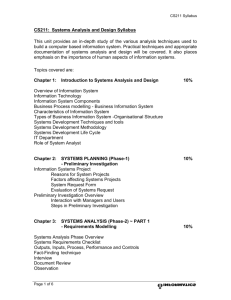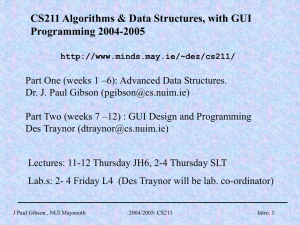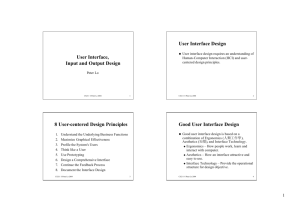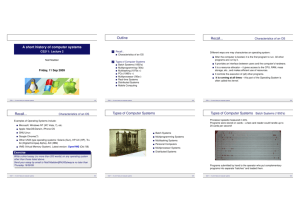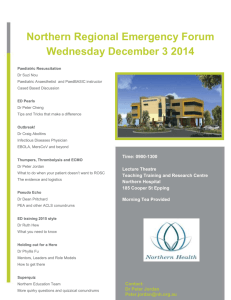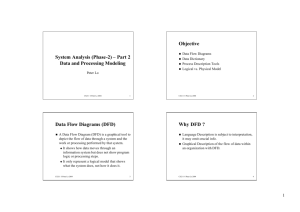Preliminary Investigation
advertisement
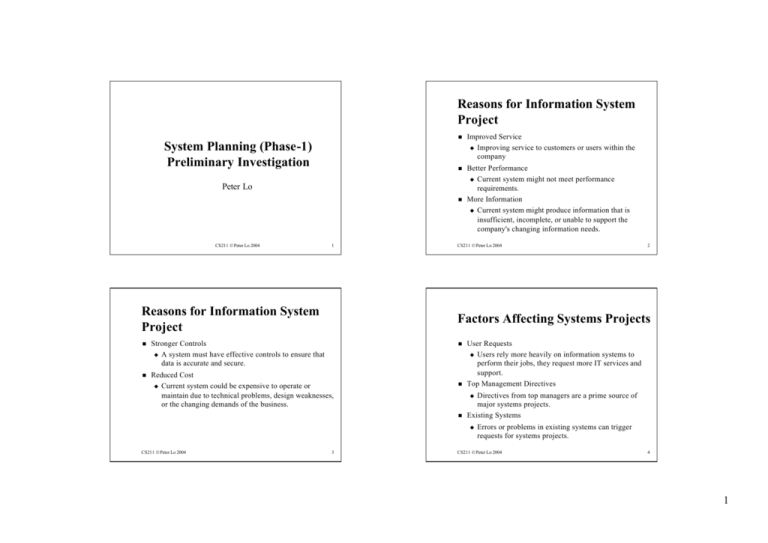
Reasons for Information System Project System Planning (Phase-1) Preliminary Investigation n Improved Service u Improving service to customers or users within the company n Better Performance u Current system might not meet performance requirements. More Information u Current system might produce information that is insufficient, incomplete, or unable to support the company's changing information needs. Peter Lo n CS211 © Peter Lo 2004 1 Reasons for Information System Project CS211 © Peter Lo 2004 Factors Affecting Systems Projects n Stronger Controls u A system must have effective controls to ensure that data is accurate and secure. n Reduced Cost u Current system could be expensive to operate or maintain due to technical problems, design weaknesses, or the changing demands of the business. n User Requests u Users rely more heavily on information systems to perform their jobs, they request more IT services and support. Top Management Directives n Directives from top managers are a prime source of major systems projects. Existing Systems n u u CS211 © Peter Lo 2004 2 3 Errors or problems in existing systems can trigger requests for systems projects. CS211 © Peter Lo 2004 4 1 Factors Affecting Systems Projects Factors Affecting Systems Projects n Information Technology Department u Many systems project requests come from the IT department. n Government u Federal, state, and local government regulations affect the design of corporate information systems. n The Economy u Economic activity has a powerful influence on corporate information management. Technology u Changing technology is a basic force in business and society in general. n Software and Hardware Vendors u Most companies have a mix of software and hardware that must work together to support information systems requirements. Competitors n CS211 © Peter Lo 2004 n u 5 Factors Affecting Systems Projects n n Customers u Customer service is vitally important, and information systems that interact with customers receive top priority in most firms. Suppliers u With the growth of Electronic Data Interchange (EDI), relationships with suppliers are critically important. CS211 © Peter Lo 2004 7 Competition drives many information systems decisions. CS211 © Peter Lo 2004 6 Systems Request Forms n n Many organizations use a special form for systems requests. When a systems request form is received, a systems analyst or IT manager examines it to determine what IT resources are required for the preliminary investigation. CS211 © Peter Lo 2004 8 2 Evaluation of Systems Requests n CS211 © Peter Lo 2004 9 Overview of Feasibility CS211 © Peter Lo 2004 10 Overview of Feasibility n n CS211 © Peter Lo 2004 Organizations assign responsibility for evaluating systems requests to a group of key managers and users. u Systems Review Committees t Provides a variety of experience and knowledge in evaluating systems requests. t Evaluate the requests and set priorities. 11 A systems request must meet several tests to see whether it is worthwhile to proceed further. A feasibility study uses three major yardsticks to measure, or predict a system's success: u Operational Feasibility u Technical Feasibility u Economic Feasibility CS211 © Peter Lo 2004 12 3 Operational Feasibility Technical Feasibility n n A system that has operational feasibility is one that will be used effectively after it has been developed. n A systems request has technical feasibility if the organization has the resources to develop or purchase, install, and operate the system. Project risk can be assessed based upon: u Project size u u u CS211 © Peter Lo 2004 13 Economic Feasibility n CS211 © Peter Lo 2004 14 Economic Feasibility A systems request has economic feasibility if the projected benefits of the proposed system outweigh the estimated costs involved in acquiring, installing, and operating it. u Cost – Benefit Analysis u Determine Costs t Tangible Costs (can easily be measured in dollars) • Example: Hardware t Intangible Costs (cannot be easily measured in dollars) • Examples: loss of customer goodwill, loss of employee morale CS211 © Peter Lo 2004 Project structure Development group ’s experience with the application User group’s experience with development projects and the application area 15 u Determine Benefits t Tangible Benefits (Can be measured easily) • Examples: Cost reduction and avoidance, Error reduction, Increased flexibility, Increased speed of activity, Improved management planning and control, Opening new markets and increasing sales opportunities t Intangible Benefits (Cannot be measured easily) • Examples: Increased employee morale, Competitive necessity, More timely information, Promotion of organizational learning and understanding CS211 © Peter Lo 2004 16 4 Preliminary Investigation Overview Economic Feasibility u u One-Time Costs t Associated with project startup, initiation and development • Includes: System Development, New hardware and software purchases, User training, Site preparation, Data or system conversion Recurring Costs t Associated with ongoing use of the system • Includes: Application software maintenance, Incremental data storage expense, New software and hardware releases, Consumable supplies, Incremental communications CS211 © Peter Lo 2004 17 n Interaction with managers and users u Meet with key managers, users, and IT staff to describe the project. CS211 © Peter Lo 2004 18 Steps in the Preliminary Investigation 1. 2. 3. 4. 5. Understand the Problem or Opportunity Define the Project Scope and Constraints Perform Fact-Finding Determine Feasibility Estimate Time and Cost to Continue Development 6. Present Results and Recommendations to Management CS211 © Peter Lo 2004 19 5
